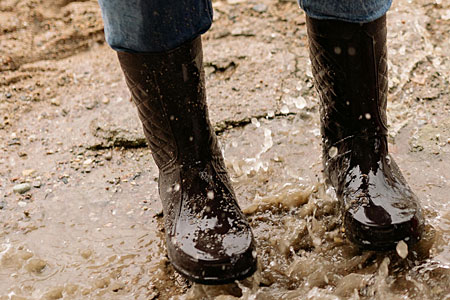
Using a boot bath before and after you visit your chickens keeps your footwear clean. More important, it enhances your biosecurity measures to ensure that your flock stays healthy. The procedure for maintaining a boot bath and sanitizer is easy and inexpensive.
Make a Boot Bath
To make a boot bath and sanitizer, you need a shallow pan that’s low enough to easily step into and wide enough to fit your entire boot. A boot tray doesn’t cost much, and an open cat litter box may be even less expensive.
In the pan place a mat for scrubbing the bottom of your boot. Some astroturf nest pads, an astroturf door mat, or an artificial grass mat cut to size all work well and are not expensive.
As a sanitizer you’ll need some sort of disinfectant. All kinds of good sanitizers are available at various prices online and in farm stores.
Or you can use a simple and inexpensive solution of sodium hypochlorite bleach. Mix one part bleach with four parts water. Pour about half an inch into the pan, or just enough to wet the mat.
Boot Cleaning Procedure
To use the boot bath and sanitizer, simply step into the pan and wipe your feet on the mat. When the disinfectant appears dirty, rinse out your boot bath and add fresh disinfectant. Since bleach degrades rapidly, freshen a bleach boot bath daily.
For the disinfectant to work, the footwear should be reasonably clean. So if any dirt or other debris is clearly visible, first use a stiff brush to remove it.
To be doubly safe, you might set up two boot baths. One with plain soap and water to clean muddy boots, the other with disinfectant to sanitize them.
Leather or fabric footwear can accumulate damage from prolonged exposure to a disinfectant. In that case, a final rinse with fresh water is in order.
If you wish to avoid using a boot bath altogether, you have a few choices. One is to wear dedicated footwear you use only when visiting your chickens and nowhere else. Another is to cover your shoes with disposable booties.
And don’t forget to ask visitors to clean and sanitize their footwear. Or have disposable boot covers on hand for them to use. For infrequent visits, tying on plastic grocery bags works, too.
And that’s today’s news from the Cackle Coop.
Gail Damerow has written several books about keeping poultry, many of them available from the Cackle Bookstore.

